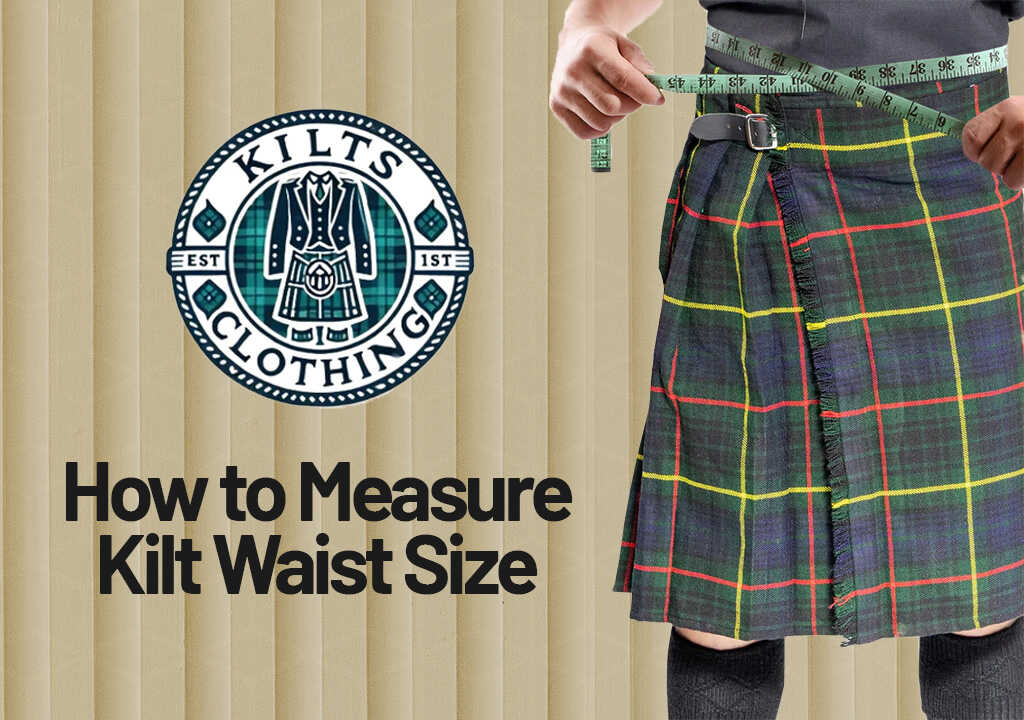How to Measure Kilt Waist Size

Achieving the perfect fit for your kilt starts with accurate measurements. A well-fitted kilt looks great and feels comfortable, allowing you to enjoy any occasion confidently. Whether attending a formal event, a casual gathering, or simply embracing your heritage, a properly measured kilt clothing makes all the difference.
This guide will provide a detailed step-by-step process for measuring your kilt waist size, ensuring you get it right the first time. From understanding where a kilt should sit to common measurement mistakes to avoid, we cover everything you need to know. We will also provide helpful tips and insights to make the measuring process easy and stress-free.
With the right tools and techniques, you can measure your kilt waist accurately and avoid the pitfalls that can lead to an ill-fitting garment. So, let's start on your journey to finding the perfect kilt fit, ensuring you look and feel your best in your traditional attire.
Understanding Kilt Measurements
Measuring for a kilt is different from measuring for regular pants. Kilts sit higher on your waist, typically around your navel, unlike pants, which sit lower on the hips. This higher placement ensures the kilt drapes correctly and stays in place, providing a kilt traditional clothing look.
Regular pants measurements are taken at the hips, but kilt measurements are taken at the natural waistline. It ensures a snug fit that won't slip and maintains the kilt's shape. Additionally, kilt length is measured from the waist to the middle of the knee, ensuring a flattering and traditional silhouette.
Accuracy in kilt clothes measurements is crucial for both comfort and appearance. Proper measurements prevent the kilt from being too tight, loose, or incorrectly sitting. By understanding these differences and measuring precisely, you can ensure a perfect fit for your kilt.
Tools You Will Need
To measure your waist accurately, gather these tools:
- A flexible measuring tape
- A mirror to check positioning
- Comfortable, form-fitting clothing
- A friend to assist, if possible
Emergence of the Utility Kilt
Measuring your waist accurately is essential to ensure your kilt fits perfectly. Follow these steps to get the right measurement:
- Step 1: Find the Right Position: Stand upright and locate your natural waistline, which is generally around your navel. It is where your kilt will sit.
- Step 2: Use the Measuring Tape: At this point, wrap the measuring tape around your waist. Ensure the tape is parallel to the floor and not twisted.
- Step 3: Take the Measurement: Hold the tape snugly against your skin without pulling it too tight. The goal is a comfortable but secure fit.
- Step 4: Double-Check the Measurement: Repeat the measurement a couple of times to ensure consistency. Accurate measurements are key to a well-fitted kilt.
- Step 5: Record the Measurement: Write down your measurement immediately to avoid any mix-up or forgetfulness.
Kids' Kilts
| Size | Waist | Standard Length | Age |
|---|---|---|---|
| Baby | 18-22" | 9" | < 24 Mos. |
| Toddler | 21-25" | 12" | 2-4 Yrs |
| Youth | 25-30" | 14" | 5-7 Yrs |
| Young Lad/Lass | 26-31" | 16" | 7-10 Yrs |
Men's and Women's Kilts
| Size | Fits Waist* | Length | Fits Waist* | Length |
|---|---|---|---|---|
| Small (S) | 25-30" | 18" | 25-30" | 18" |
| Medium (M) | 27-33" | 20" | 27-33" | 18" |
| Mens Medium Long (ML) | 27-33" | 22.5" | -- | -- |
| Large (L) | 34-38" | 22.5" | 34-38" | 18" |
| Extra Large (XL) | 39-46" | 22.5" | 39-46" | 18" |
| Extra Extra Large (XXL) | 47-54" | 22.5" | -- | -- |
Men's Kilts
| Size | Fits Waist* | Length |
|---|---|---|
| Mens Small (S) | 25-30" | 18" |
| Mens Medium (M) | 27-33" | 20" |
| Mens Medium Long (ML) | 27-33" | 22.5" |
| Mens Large (L) | 34-38" | 22.5" |
| Mens Extra Large (XL) | 39-46" | 22.5" |
| Mens Extra Extra Large (XXL) | 47-54" | 22.5" |
Common Mistakes to Avoid
To ensure an accurate measurement, avoid these common mistakes:
- Measuring over thick or bulky clothing can add extra inches to your measurement, resulting in a too-large kilt. Always measure over thin, form-fitting clothing or directly on your skin for the most accurate measurement.
- A too-tight tape can lead to an uncomfortable and restrictive kilt, while a too-loose tape can result in a kilt that doesn't stay in place. The measuring tape should be snug against your skin but not constricting.
- Measuring at the wrong location on your body can significantly affect the fit of your kilt. Ensure you measure at your natural waistline, typically around the navel, as this is where the kilt should sit for the best fit and traditional look.
- Slouching or tensing your body can alter your natural waist size. Stand upright with your stomach relaxed to get an accurate measurement that reflects your normal posture.
- Using a rigid ruler or a non-flexible tape can lead to accuracy. Always use a flexible measuring tape to follow the contours of your body accurately.
- Only measuring once can lead to mistakes. Measure a couple of times to ensure Consistency and accuracy. This practice helps confirm that your measurements are correct.
- While it is possible to measure yourself, having someone assist you can ensure the tape remains level and snug, improving the accuracy of your measurements.
- You need to write down your measurements to avoid errors. Always record your measurements after taking them to ensure you have the correct figures.
Avoiding these common mistakes will help ensure your kilt fits perfectly, providing comfort and style. Accurate measurements are essential for achieving a well-fitted kilt that enhances your appearance and allows you to wear it confidently.
Tips for Accurate Measurement
Accurate measurement is key to ensuring your kilt fits perfectly. Here are some essential tips to help you measure correctly:
- Use the Right Tools: A flexible measuring tape is ideal for taking body measurements. Avoid using rigid rulers or non-flexible tapes, which can lead to inaccurate measurements.
- Measure at the Right Time: Measure your waist at different times of the day to account for natural fluctuations in body size. For the most accurate result, measure when you are relaxed and standing upright.
- Stand Correctly: Stand straight with your feet together, and your stomach relaxed. This posture helps ensure the measurement reflects your natural waist size.
- Ensure the Tape is Parallel: Ensure the measuring tape is parallel to the floor and level around your waist. A tilted or twisted tape can give incorrect measurements.
- Get Assistance: Have someone help you with the measurement. It can ensure the tape is straight and snug, making the process easier and more accurate.
- Double-Check Your Measurements: Take the measurement a couple of times to ensure consistency. It reduces the risk of errors and confirms that you have the correct size.
- Record Immediately: Write down your measurements immediately to ensure clarity. Accuracy is crucial for a perfect fit.
- Avoid Bulky Clothing:Measure over thin, form-fitting clothing or directly on your skin for the most accurate measurement. Bulky clothing can add extra inches and lead to an incorrect size.
- Relax and Breathe Normally: Don't suck in your stomach or hold your breath while measuring. Breathe normally to ensure the measurement reflects your true waist size.
Following these tips ensures your kilt measurements are precise, leading to a comfortable and well-fitted garment. Accurate measurements are the foundation of a stylish and perfectly fitted kilt, enhancing your comfort and appearance.
Conclusion
Achieving a comfortable and stylish kilt begins with accurate waist measurement. By following the steps and tips provided, you can ensure your kilt fits perfectly.
Take your time to measure at your natural waistline, typically around the navel. Use a flexible measuring tape, stand straight, and double-check your measurements for accuracy.
A well-fitted kilt not only looks great but also feels comfortable, allowing you to enjoy any occasion with confidence. With precise measurements, you can look forward to wearing a kilt that combines traditional elegance with a perfect fit.
FAQ's
To find your kilt size, measure your waist where you want the kilt to sit, usually around the navel. Ensure the measuring tape is snug but not too tight, and record the measurement.
Kilt sizing involves measuring the waist at the desired point and the length from the waist to the desired length (usually the middle of the knee). Different styles of kilts may have specific measurement requirements.
A kilt should sit at your natural waistline, typically around the navel. This positioning ensures a comfortable and traditional fit.
To measure for a kilt belt, measure around your waist at the point where the kilt will sit. It is usually the same as your kilt waist measurement.
Waist belts are measured from the buckle’s end to the belt’s middle hole. For a perfect fit, this measurement should match your kilt waist measurement.
To alter a kilt waist, you can adjust the straps and buckles for a minor change. It is best to consult a professional tailor specializing in kilts for significant alterations.

